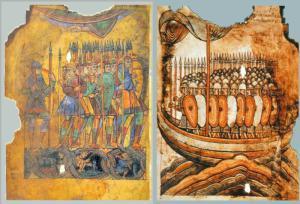The Truth About Viking Armor: No Horns, No Uniformity Either.

10th Century Chieftain
While the History Channel would have us believe they were a leather-clad biker gang akin to the Sons of Anarchy, the real Vikings would have had a much more diverse wardrobe. It is first important to understand that the Viking Age lasted almost three centuries, during which styles and clothing changed. Early raids in the 8th century were carried out by small groups of free warriors, banded together for the purpose of pillaging and acquiring wealth to take home. One hundred years later, the West came under siege as ambitious warlords repurposed their warriors for invasion requiring a refitting of their battle gear to withstand the test of large confrontations. This begs the question: what did they really wear?
Early on during the Viking Age, the warriors of various raiding parties would have worn what they could afford, as well as what worked at sea. Anyone who has worn leather knows that salt water is incredibly corrosive to it, making it tough and unwearable. Therefore leather would have been sparse. A more common type of clothing for the era was cloth: heavy interweaved fabric designed to absorb slashing blows (but not stabs). Cloth would have kept sailors warmer at sea as well, and anyone who has ever sailed knows how cold the ocean’s winds can be, even on a hot, sunny day. Cloth unfortunately does not leave much behind for us to find or add to the archeological record. We may only deduce that it was the clothing of choice because of availability, and because of the universal use of cloth protection across the western world at the time.
Later in the Viking Age the Vikings diversified their wardrobes. The riches they brought home from raids increased the wealth of the average free warrior, allowing him to invest in heavier pieces of equipment. Wealth was not the only import to Scandinavia either. Vikings brought home new technologies for farming and building, as well as weapon making. Does this mean they all began to wear mail and steel helmets? Perhaps not, but there is evidence to suggest that some armies at least may have done just that: equip everyone with the best armor money could buy. Below is a depiction of a 10th century attack on Guérande in which the Vikings (in a ship on the right) are all equipped with shield, helmet, hauberk, and lance. (click to enlarge)
The above drawing is of the 10th Century invasion of Brittany, which led to a 20 year occupation of the region, including the cities of Rennes and Nantes. In fact, the Breton leaders who expelled the Vikings only did so after they had craftily turned the Normans in Normandy against the Normans in Brittany. What this evidence tells us is that the Vikings repurposed their armies to suit their ambitions. Early raiders could not stand up to the better equipped Frankish armies of Charlemagne and Louis I, but as they increased their wealth and shifted their ambitions, they became better equipped and more organized. Depending on the region they attacked, the Vikings adapted to their enemy and adopted forms of arms and armor influenced by those who they fought. For example, on the island of Groix in southern Brittany a Norman burial dating to the mid-10th Century yielded twenty-four shields of a unique design which historians suppose were built by the occupying army. It is demonstrative of the willingness of the Northmen to improve their equipment, and also shows us that their equipment would have been diverse across the world.
So what did they really wear? The answer is that they wore what suited them for the time and place. In the West, they began to resemble their British, Breton, and Frankish neighbors. In the East, they began to resemble the Byzantines and the Slavs they occupied. Uniformity was not their strong suit, and this was perhaps their secret to success: adaptability. There is a great deal of conjecture and interpretation in dealing with what the Vikings wore, and there is still a great deal that we do not know. We do know that as the Viking Age progressed, the attire became more region-specific. A viking in Brittany in the 9th Century would have appeared different from a Varangian in Constantinople in the 10th Century. The only universal piece they all wore was a beard; it was cultural and several sources mention how shameful it was if a free warrior could not grow one.
Sponsored Ad






